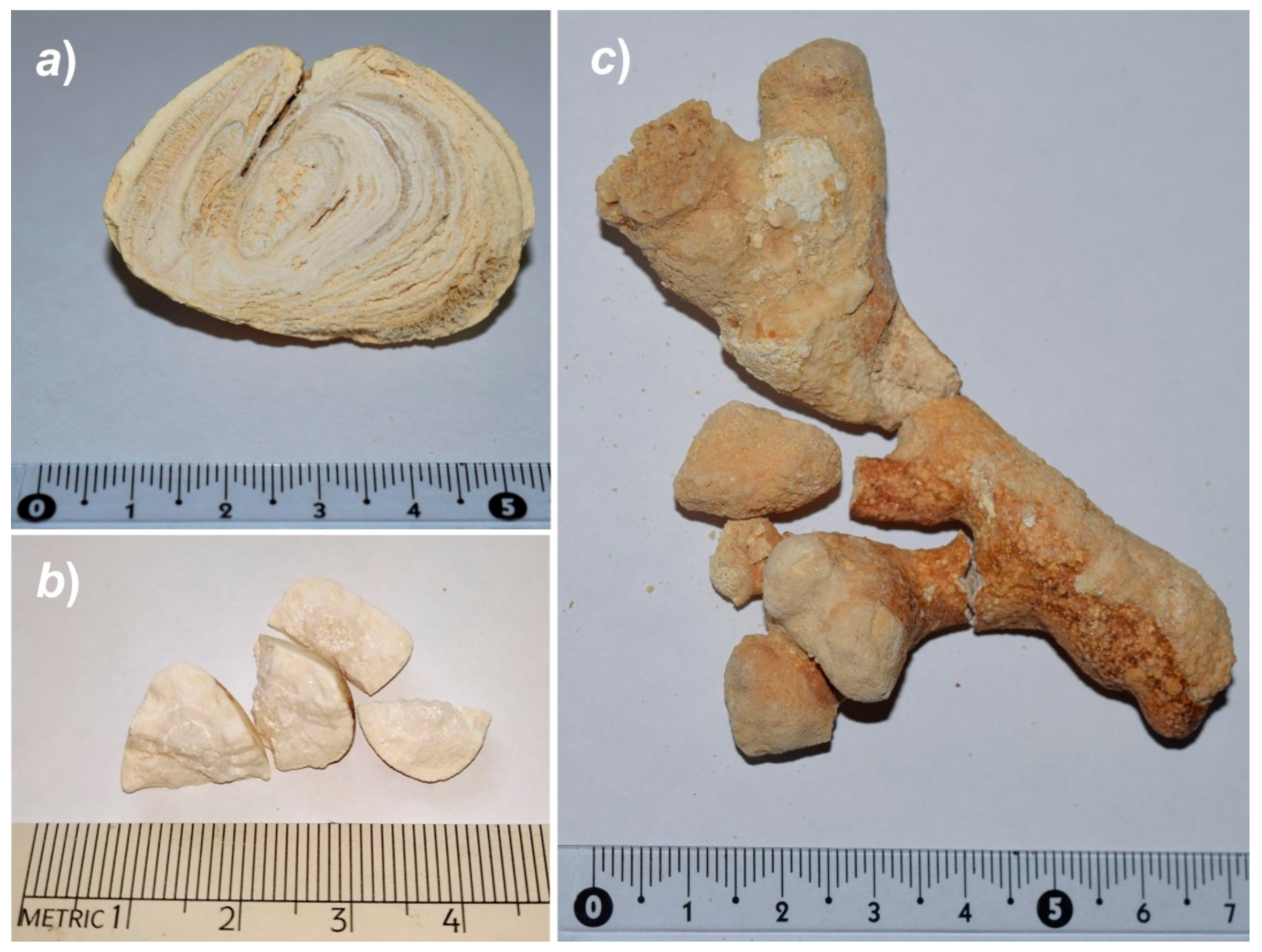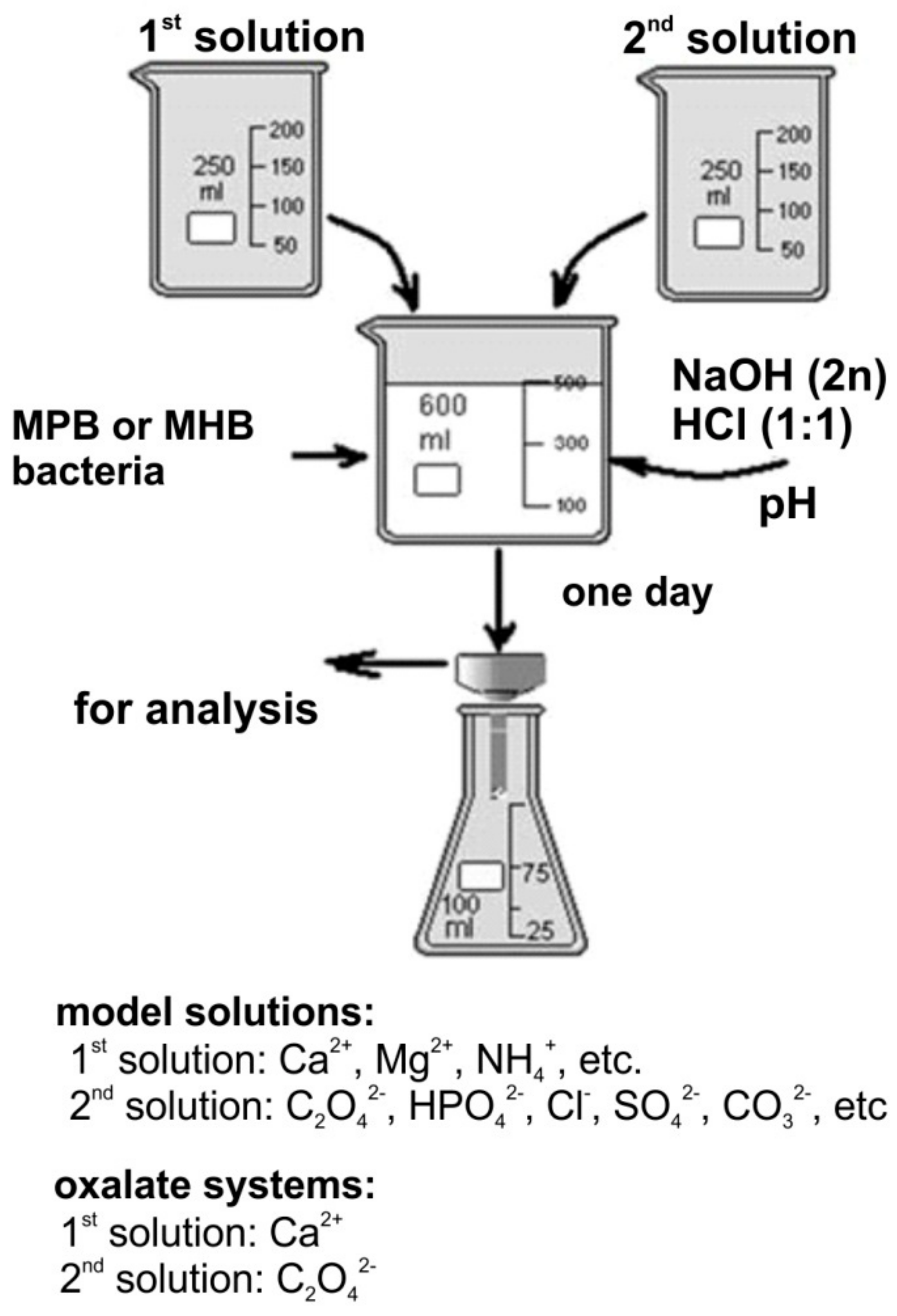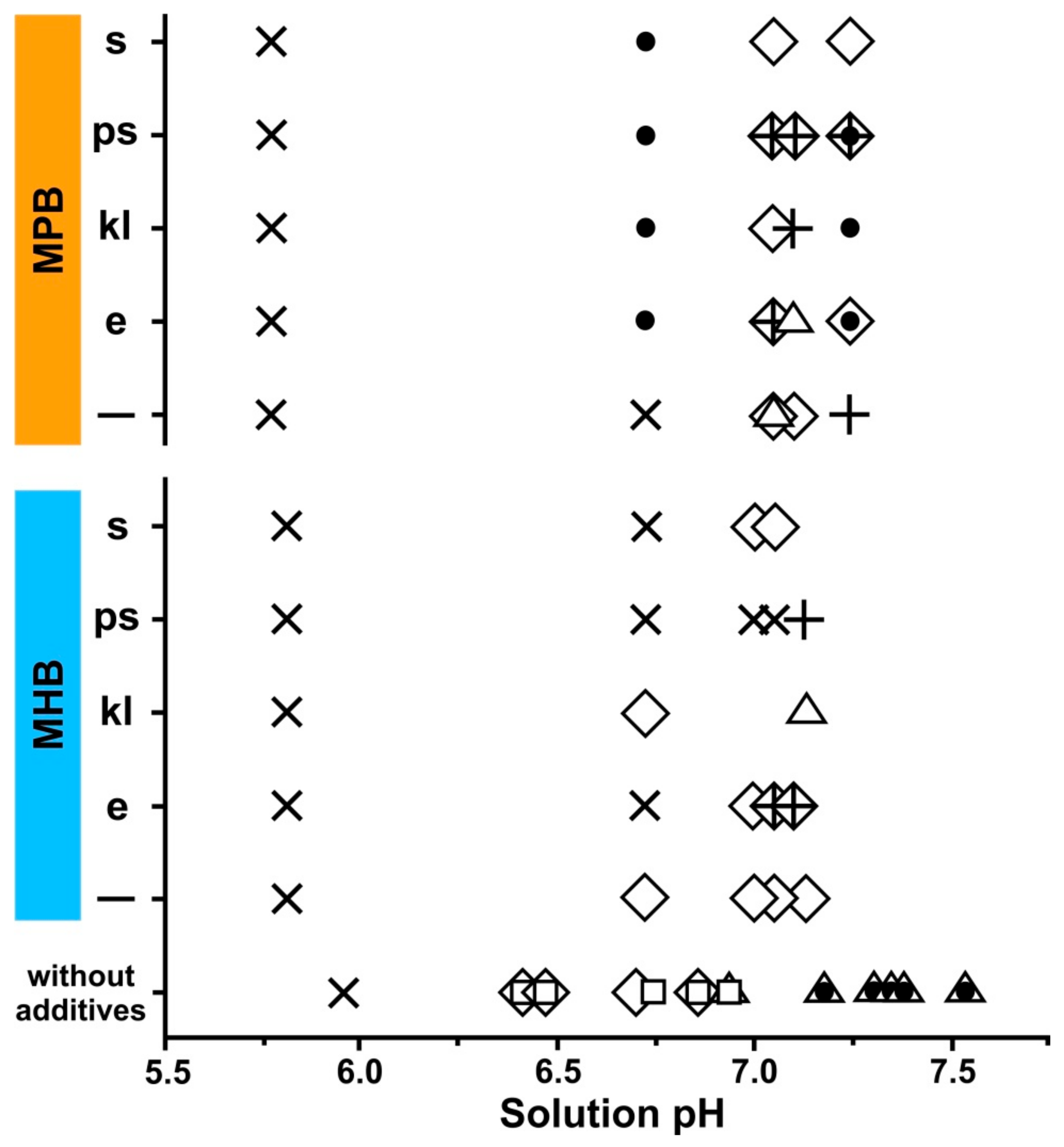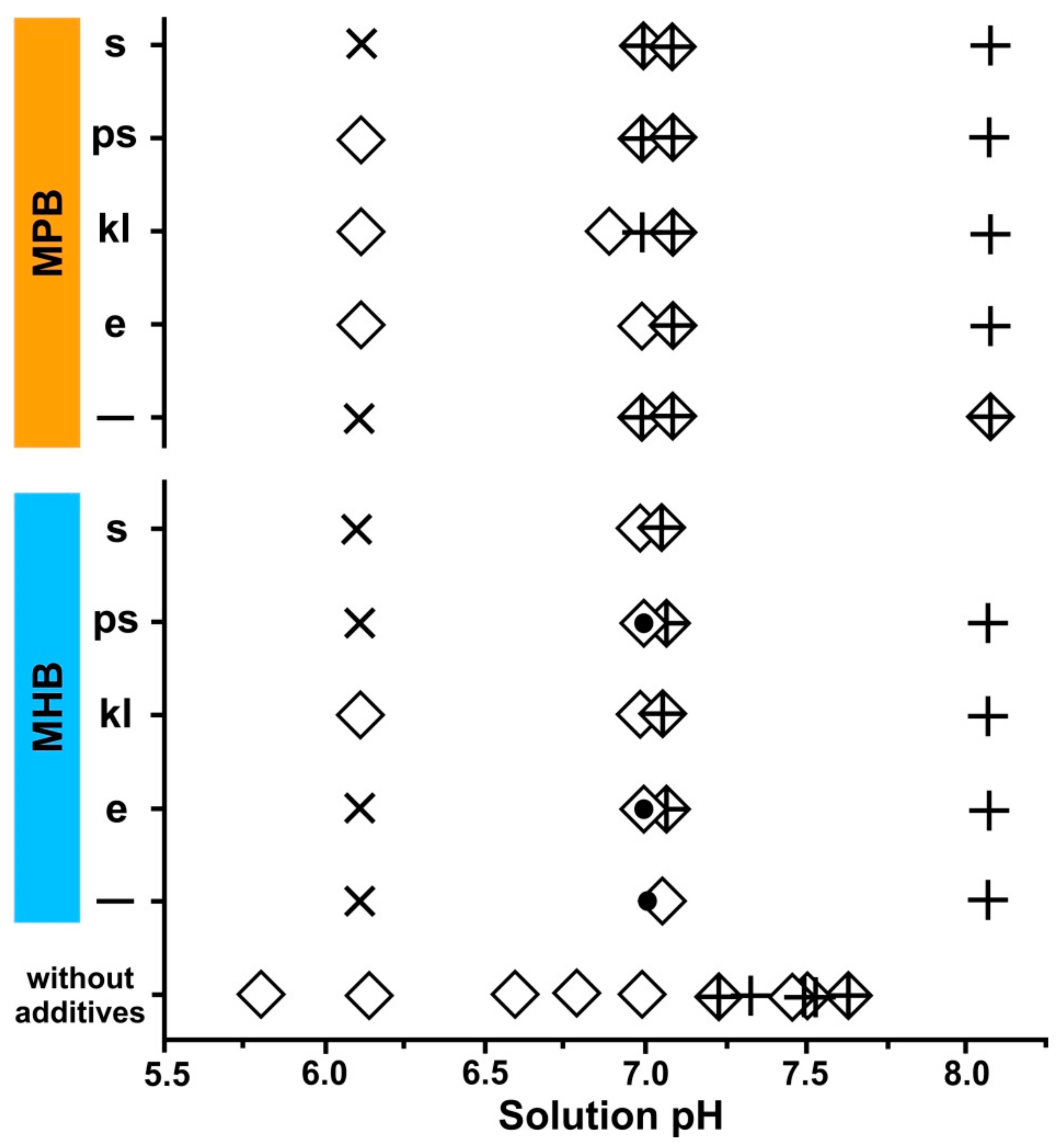Bacterial Effect on the Crystallization of Mineral Phases in a Solution Simulating Human Urine
Abstract
:1. Introduction
2. Materials and Methods
3. Results
3.1. pH Changes of the Medium
3.2. Model Solutions with Minimum Concentrations of Additional Ions Characteristic of a Healthy Person’s Urine Composition
3.3. Model Solutions with Maximum Concentrations of Additional Ions Characteristic of a Healthy Person’s Urine Composition
3.4. Crystallization in the Oxalate System
4. Discussion
5. Conclusions
Author Contributions
Funding
Acknowledgments
Conflicts of Interest
References
- Khan, S.R.; Kok, D.J. Modulators of urinary stone formation. Frontiers Biosci. 2004, 9, 1482. [Google Scholar] [CrossRef]
- Seregin, A.V.; Mulabaev, N.S.; Tolordava, E.R. Urolithiasis: Current aspects of etiology and pathogenesis. Med. Buisiness 2012, 4, 4–10. [Google Scholar]
- Balaji, K.C.; Menon, M. Mechanism of stone formation. Urol. Clin. N. Am. 1997, 24, 1–11. [Google Scholar] [CrossRef]
- Bauza, J.L.; Pieras, E.C.; Grases, F.; Tubau, V.; Guimerà, J.; Sabaté, X.A.; Pizà, P. Urinary tract infection’s etiopathogenic role in nephrolithiasis formation. Med. Hypotheses 2018, 118, 34–35. [Google Scholar] [CrossRef] [PubMed]
- Evan, A.P. Physiopathology and etiology of stone formation in the kidney and the urinary tract. Pediatr Nephrol 2010, 25, 831–841. [Google Scholar] [CrossRef] [PubMed]
- Fleming, D.E.; Bronswijk, W.V.; Ryall, R.L. A comparative study of the adsorption of amino acids on to calcium minerals found in renal calculi. Clin Sci 2001, 101, 159–168. [Google Scholar] [CrossRef] [PubMed]
- Grases, U.F.; Costa-Bauzá, A.; García-Ferragut, L. Biopathological crystallization: A general view about the mechanisms of renal stone formation. Adv. Colloid. Interface. Sci. 1998, 74, 169–194. [Google Scholar] [CrossRef]
- Korago, A.A. Introduction to Biomineralogy; Nedra: St. Petersburg, Russia, 1992; p. 280. [Google Scholar]
- Tiktinskiy, O.L.; Aleksandrov, V.P. Urolithiasis; Liter: St. Peterburg, Russia, 2000; p. 384. [Google Scholar]
- Waltona, R.C.; Kavanagha, J.P.; Heywoodb, B.R.; Rao, P.N. Calcium oxalates grown in human urine under different batch conditions. J. Cryst. Growth 2005, 284, 517–529. [Google Scholar] [CrossRef]
- Jan, H.; Akbar, I.; Kamran, H.; Khan, J. Frequency of renal stone disease in patients with urinary tract infection. J. Ayub Med. Coll. 2008, 20, 60–62. [Google Scholar]
- Bichler, K.-H.; Eipper, E.; Naber, K.; Braun, V.; Zimmermann, R.; Lahme, S. Urinary infection stones. Int. J. Antimicrob. Ag. 2002, 19, 488–498. [Google Scholar] [CrossRef]
- Borghi, L.; Nouvenne, A.; Meschi, T. Nephrolithiasis and urinary tract infections: ‘The chicken or the egg’ dilemma? Nephrol. Dial. Transplant. 2012, 27, 3982–3985. [Google Scholar] [CrossRef]
- Romanova, Y.M.; Mulabaev, N.S.; Tolordava, E.R.; Seregin, A.V.; Seregin, I.V.; Alexeeva, N.V.; Stepanova, T.V.; Levina, G.A.; Barhatova, O.I.; Gamova, N.A.; et al. Microbial communities on kidney stones. Mol. Genet. Microbiol. Virol. 2015, 2, 20–25. [Google Scholar] [CrossRef]
- Costerton, J.W.; Stewart, P.S.; Greenberg, E.P. Bacterial biofilm: A common cause of persistent infections. Science 1999, 284, 1318–1322. [Google Scholar] [CrossRef]
- Musk, D.J.; Hergenrother, P.J. Chemical countermeasures for the control of bacterial biofilms: Effective compounds and promising targets. Cur. Med. Chem. 2006, 18, 2163–2177. [Google Scholar] [CrossRef]
- Cógain, M.R.; Lieske, J.C.; Vrtiska, T.J.; Tosh, P.K.; Krambeck, A.E. Secondarily infected non-struvite urolithiasis: A prospective evaluation. Urology 2014, 84, 1295–1300. [Google Scholar] [CrossRef]
- Chen, L.; Shen, Y.; Jia, R.; Xie, A.; Huang, B.; Cheng, X.; Zhang, Q.; Guo, R. The role of escherichia coliform in the biomineralization of calcium oxalate crystals. Eur. J. Inorg. Chem. 2007, 20, 3201–3207. [Google Scholar] [CrossRef]
- Zhao, Z.; Xia, Y.; Xue, J.; Wu, Q. Role of E. coli-secretion and melamine in selective formation of CaC2O4·H2O and CaC2O4·2H2O. Cryst. Growth Des. 2014, 14, 450–458. [Google Scholar] [CrossRef]
- Jamshaid, A.; Ather, M.N.; Hussain, G.; Khawaja, K.B. Single center, single operator comparative study of the effectiveness of electrohydraulic and electromagnetic lithotripters in the management of 10- to 20-mm single upper urinary tract calculi. Urol. 2008, 72, 991–995. [Google Scholar] [CrossRef]
- Izatulina, A.R.; Yelnikov, V. Structure, chemistry and crystallization conditions of calcium oxalates—The main components of kidney stones. In Minerals as Advanced Materials I; Krivovichev, S., Ed.; Springer: Berlin, Germany, 2008; pp. 231–241. [Google Scholar]
- Borodin, E.A. Biochemical Diagnosis; V. 1,2; Amuruprpoligraphizdat: Blagoveschensk, Russia, 1989; p. 77. [Google Scholar]
- GOST 20730-75. Nutrient Media. Meat-Peptone Broth (for Veterinary Purposes); № 899; Standards publishing house: Moscow, Russia, 1975. (in Russian) [Google Scholar]
- Mueller, J.H.; Hinton, J. A protein free medium for primary isolation of gonococcus and meningococcus. Proc. Soc. Exp. Biol. Med. 1941, 48, 330–333. [Google Scholar] [CrossRef]
- Moskalev, Y.I. Mineral Exchange; Medicine: Moscow, USSR, 1985; p. 288. [Google Scholar]
- Topas V4.2: General Profile and Structure Analysis Software for Powder Diffraction Data; Bruker AXS: Karlsruhe, Germany, 2009.
- Kuz’mina, M.A.; Nikolaev, A.M.; Frank-Kamenetskaya, O.V. The formation of calcium and magnesium phosphates of the renal stones depending on the composition of the crystallization medium. In Processes and Phenomena on the Boundary between Biogenic and Abiogenic Nature; Springer: Basel, Switzerland, 2019. (In press) [Google Scholar]
- Nikolaev, A.M.; Kuz’mina, M.A.; Izatulina, A.R.; Frank-Kamenetskaya, O.V.; Malyshev, V.V. Influence of the albumin substance and bacteria on formation of urinal phosphate stones (According to results of the modelling experiment). Zapiski RMO (Proceedings of the Russian Mineralogical Society, in Russian) 2014, 143, 120–133. [Google Scholar]
- Izatulina, A.R.; Gurzhiy, V.V.; Frank-Kamenetskaya, O.V. Weddellite from renal stones: Structure refinement and dependence of crystal chemical features on H2O content. Amer. Min. 2014, 99, 2–7. [Google Scholar] [CrossRef]
- Wong, T.Y.; Wu, C.Y.; Martel, J.; Lin, C.W.; Hsu, F.Y.; Ojcius, D.M.; Lin, P.Y.; Young, J.D. Detection and characterization of mineralo-organic nanoparticles in human kidneys. Sci. Rep. 2015, 5, 15272. [Google Scholar] [CrossRef] [PubMed]
- El’nikov, V.Yu.; Rosseeva, E.V.; Golovanova, O.A.; Frank-Kamenetskaya, O.V. Thermodynamic and experimental modeling of the formation of major mineral phases of uroliths. Russ. J. Inorg. Chem. 2007, 52, 50–157. [Google Scholar] [CrossRef]
- Chutipongtanate, S.; Sutthimethakorn, S.; Chiangjong, W.; Thongboonkerd, V. Bacteria can promote calcium oxalate crystal growthand aggregation. J. Biol. Inorg. Chem. 2013, 18, 299–308. [Google Scholar] [CrossRef] [PubMed]




| Component | Model Solution | Human Urine [22,25] | |
|---|---|---|---|
| Min Concentration | Max Concentration | ||
| Na+ | 60 | 73 | 67–133 |
| K+ | 21.7 | 102 | 33–47 |
| Ca2+ | 5–7.7 | 5–7.7 | 1.7–5 |
| Mg2+ | 5.3 | 11 | 5.3–11 |
| NH4+ | 20.8 | 49.4 | 20–50 |
| Cl- | 67 | 80 | 67–167 |
| CO32- | 0 | 33 | 0–33 |
| PO43- | 13 | 33 | 13–33 |
| SO42- | 21.7 | 69 | 27–80 |
| Additives | Minimum Concentration | Maximum Concentration | |||
|---|---|---|---|---|---|
| Nutrient Medium | Bacteria | Initial pH | Final pH | Initial pH | Final pH |
| none | none | 5.95–7.54 | 5.94–6.71 | 5.81–7.73 | 5.75–7.50 |
| Müller–Hinton Broth | none | 5.81–7.15 | 5.84–6.25 | 6.10–8.07 | 6.27–7.39 |
| Escherichia coli (“e”) | 5.81–7.15 | 5.27–6.39 | 6.10–8.07 | 5.85–7.35 | |
| Klebsiella pneumoniae (“kl”) | 5.81–7.15 | 5.51–6.40 | 6.10–8.07 | 5.84–7.50 | |
| Pseudomonas aeruginosa (“ps”) | 5.81–7.15 | 6.21–6.51 | 6.10–8.07 | 6.16–7.90 | |
| Staphylococcus aureus (“s”) | 5.81–7.15 | 5.06–6.45 | 6.10–8.07 | 5.66–7.54 | |
| Meat–Peptone Broth | none | 5.77–7.26 | 5.78–7.08 | 6.10–8.03 | 6.18–7.90 |
| Escherichia coli (“e”) | 5. 77–7.26 | 5.94–7.02 | 6.10–8.03 | 6.07–7.67 | |
| Klebsiella pneumoniae (“kl”) | 5.77–7.26 | 5.90–7.00 | 6.10–8.03 | 6.03–7.80 | |
| Pseudomonas aeruginosa (“ps”) | 5.77–7.26 | 6.39–7.40 | 6.10–8.03 | 6.18–7.90 | |
| Staphylococcus aureus (“s”) | 5.77–7.26 | 6.25–7.23 | 6.10–8.03 | 6.14–8.05 | |
| Bacteria | Nucleation Time, s | ||
|---|---|---|---|
| γ = 3 | γ = 7 | γ = 10 | |
| None | More than 2400 (>40 min) | 840 | 140 |
| Staphylococcus aureus | 1500 | 510 | 30–50 |
| Klebsiella pneumoniae | 1290 | 470 | 30–50 |
| Escherichia coli | 1200 | 420 | 30–50 |
| Pseudomonas aeruginosa | 1140 | 370 | 30–50 |
| Additives | Whewellite/Weddellite Ratio | Selected Crystallographic Data for the Weddellite Phase | |
|---|---|---|---|
| Unit Cell Parameter, Å | Amount of “Zeolite” Water (x), p.f.u. * | ||
| None | whewellite | – | – |
| Ovalbumin | 5:2 | 12.349(1) | 0.26 |
| Escherichia coli | 5:2 | 12.344(1) | 0.23 |
| Pseudomonas aeruginosa | 5:2 | 12.341(2) | 0.21 |
| Staphylococcus aureus | 5:2 | 12.346(2) | 0.24 |
© 2019 by the authors. Licensee MDPI, Basel, Switzerland. This article is an open access article distributed under the terms and conditions of the Creative Commons Attribution (CC BY) license (http://creativecommons.org/licenses/by/4.0/).
Share and Cite
Izatulina, A.R.; Nikolaev, A.M.; Kuz’mina, M.A.; Frank-Kamenetskaya, O.V.; Malyshev, V.V. Bacterial Effect on the Crystallization of Mineral Phases in a Solution Simulating Human Urine. Crystals 2019, 9, 259. https://doi.org/10.3390/cryst9050259
Izatulina AR, Nikolaev AM, Kuz’mina MA, Frank-Kamenetskaya OV, Malyshev VV. Bacterial Effect on the Crystallization of Mineral Phases in a Solution Simulating Human Urine. Crystals. 2019; 9(5):259. https://doi.org/10.3390/cryst9050259
Chicago/Turabian StyleIzatulina, Alina R., Anton M. Nikolaev, Mariya A. Kuz’mina, Olga V. Frank-Kamenetskaya, and Vladimir V. Malyshev. 2019. "Bacterial Effect on the Crystallization of Mineral Phases in a Solution Simulating Human Urine" Crystals 9, no. 5: 259. https://doi.org/10.3390/cryst9050259
APA StyleIzatulina, A. R., Nikolaev, A. M., Kuz’mina, M. A., Frank-Kamenetskaya, O. V., & Malyshev, V. V. (2019). Bacterial Effect on the Crystallization of Mineral Phases in a Solution Simulating Human Urine. Crystals, 9(5), 259. https://doi.org/10.3390/cryst9050259







